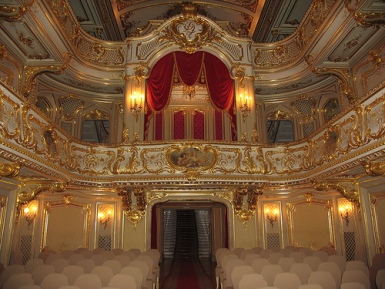

Reki Moiki Naberezhnaya 94
Tel. 314- 9883,
314- 8893
Open: 11am- 5pm daily
Bus: 3, 10, 22, 27
The Yusupov Palace on the Moika (Yusupov Palace) is a former
palace in St. Petersburg, a monument of history and culture of
federal significance. Located on the embankment of the Moika River,
the territory of the palace with a garden extends to Dekabristov
Street. The palace went down in history as the site of the murder of
Grigory Rasputin.
Currently, the building houses the Palace
of Culture of Educational Workers, which in the 1990s was formed
into a multifunctional historical and cultural center that combines
educational, excursion, exhibition and concert activities.
Already on the first maps of St. Petersburg, this place was a wooden
palace, small in those days, and the estate of Princess Praskovya
Ivanovna (niece of Peter I).
In 1726, the estate was donated by
the princess to the Semyonovsky regiment, which stayed there until 1742,
then it was bought by General P.I. Shuvalov, an influential nobleman
under Elizabeth Petrovna.
On the engraving by M. I. Makhaev “View
from the Kryukov Canal up the Moika River with the Image of the Palace
of P. I. Shuvalov” (1757-1759), next to the Shuvalov Palace, the picture
shows a two-story building of the future Yusupov Palace.
In the
1770s, the construction of the modern building of the palace began,
designed by Jean-Baptiste Vallin-Delamote for Count Andrei Petrovich
Shuvalov.
The appearance of the palace was significantly
different from the modern one: the side risalits had only two floors,
from the side of the Moika there was an entrance arch leading to the
courtyard; the main entrance to the palace was from the courtyard. The
triumphal gates have been preserved unchanged since those times - an
arch (from the side of Decembrists Street) and a seven-meter-high fence
with a classical colonnade.
In 1789, after the death of Shuvalov,
the house passed to his daughter Alexandra and son Pavel.
In
1795, Catherine II bought the estate to the treasury and presented it to
the niece of G. A. Potemkin, Countess A. V. Branitskaya, at that time
her close friend:
Purchased by our will from the heirs of the
late really Privy Councilor Count A.A. Shuvalov, the house in St.
Petersburg, lying on the Moika, We granted our lady of state Countess
Branitskaya into eternal hereditary possession, commanding that house to
be given to her with all the clothes ...
In 1830, the palace was
purchased by Boris Nikolayevich Yusupov for 250 thousand rubles in
banknotes from the previous mistress of advanced age "with all the
accessories that are on the face." From then until 1917, five
generations of the Yusupov princes owned the palace. The palace became
known as the "Yusupov Palace", although it was only one of 57 palaces in
Russia that belonged to them.
A significant restructuring was
carried out from 1830 to 1838 (architect A. A. Mikhailov 2nd):
Lateral risalits became three-storied.
A new building with the White
Column (Banquet) Hall was erected on the east side.
The outbuildings
were connected, and art galleries and a home theater in the Baroque
style were arranged in them.
New greenhouses and a garden pavilion
were built.
The garden was laid out.
The main staircase from the
side of the Moika was arranged.
The Dance Hall, Green, Imperial and
Blue drawing rooms were created.
During the perestroika, Italian
masters worked on the interiors, including A. Vigi and B. Medici.
In 1832-1834, the architect Mikhailov also expanded the palace with
an extension along the eastern side of another building that housed five
halls and a theater.
In 1881, the architect A.D. Schilling built
the Church of the Intercession at the palace (not preserved).
In
1890-1916, an extensive internal restoration of the palace was carried
out under the guidance of the architect A. A. Stepanov. In the early
1890s, electricity, sewage and water supply, central heating (water)
were installed in the palace, the theater was rebuilt and the
Mauritanian drawing room was created. In 1914, the Great Living Room,
Great Hall, Dining Room were created.
Murder of Rasputin
On
the night of December 17 (30), 1916, Grigory Rasputin was killed in the
palace.
Prince Felix Yusupov was exiled to his estate "Rakitnoe"
for participating in a conspiracy to kill, and the palace was handed
over to proxies.